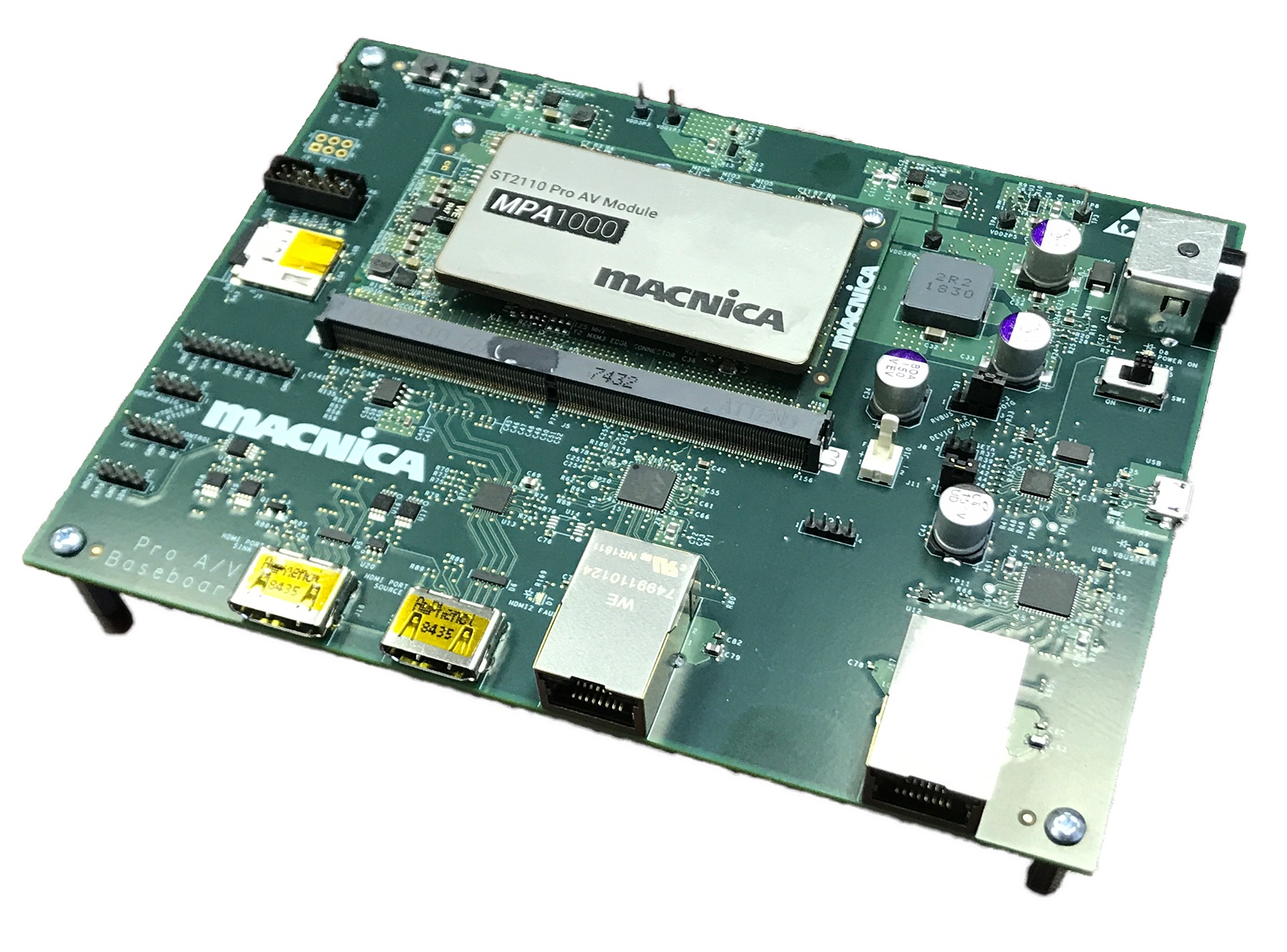IPMX: The Next Great AV Standard?
This fast-emerging set of open standards and specifications is designed for uncompressed video transport over IP.

If you’re in AV, IPMX is an acronym you need to know.
Short for Internet Protocol Media Experience, IPMX is a fast-emerging set of open standards and specifications for AV-over-IP. Although it shares many of the advantages offered by NewTek’s NDI (Network Device Interface), IPMX is different because it is an open standard.

“That means anyone with the documents will be able to make any product with it, without restrictions,” explained Andrew Starks, director of product management for Macnica Technology and board member of the Alliance for IP Media Solutions (AIMS), which is spearheading the development and deployment of IPMX in pro AV and other markets. “Also, the specifications have gone through a rigorous process involving the work of dozens of engineers around the world from many different companies. The result is a stable foundation that everyone in the industry can confidently invest in and build products upon.”
Strong Foundation, Solid Support
As it nears completion of its second major milestone, which includes the core features required by pro AV, IPMX comes with an impeccable pedigree. It starts with proven standards like AES 67 and ST 2110 for audio and video, then adds the Advanced Media Workflow Association’s (AMWA's) Networked Media Open Standards (NMOS) for an HTTP-based protocol, and extends them to include everything required in pro AV applications.
“AV-over-IP has evolved,” Starks added. “While customers have several excellent options for their deployments, interoperability is the key problem. Also, none of the existing options can cover every use case, and none of them are open in the sense that they are all controlled by a single company and their implementation of the technology.”

With IPMX, AIMS is hoping to change all that. The nonprofit industry consortium works closely with “end users, consultants, academia, services providers, manufacturers, and standards bodies on market intelligence and feedback loops regarding open standards for performance media systems operating on internet protocol (IP),” said Samuel A. Recine, vice president of sales with Matrox Video (Americas and Asia Pacific), who also serves as chair of the AIMS Pro AV Working Group.
A daily selection of the top stories for AV integrators, resellers and consultants. Sign up below.
According to Recine, AIMS also collaborates with AMWA, the Video Services Forum (VSF), Society of Motion Picture and Television Engineers (SMPTE), European Broadcast Union (EBU), and Audio Engineering Society (AES). The list of AIMS members is similarly impressive and includes AJA Video Systems, Arista Networks, Canon, Inc., Disney, EVS, Grass Valley, Harmonic, Imagine Communications, Lawo, Macnica, Matrox, NBC Universal, Net Insight, Panasonic, Ross Video, and Yamaha, among others.
What IPMX Offers AV
Beyond ST 2110's existing features, IPMX offers a range of benefits to pro AV, including simplified networking to enable the addition of new AV equipment without causing latency or quality problems, improved HDMI support for extended display identification data (EDID) and hot-plug events management, and content protection including high-bandwidth digital content protection (HDCP) management. Enhanced cybersecurity across product types and brands is a key aim of open standards like IPMX, which Recine described as still being very self-regulated by individual solution providers.

“The security management and encryption of the payload layer is, for the moment, left mainly to the implementers of various products and technologies, and is not always done the same way,” he explained. “This represents a burden for asset managers who need to develop vulnerability and security testing, logging, and management processes for each of them. IPMX represents an opportunity to introduce to the payload layer of performance media networks what https, TLS, and AES have done for the communication and control layer.”
That’s not all: IPMX not only supports raw, uncompressed video transport over IP (based on ST 2110), but adds a 1 Gbps pro AV video and audio transport for 4K/60p 4:4:4 optimized for all media content. “IPMX's main appeal lies in the continuation of proven ST 2110 capabilities in an open standard, making it possible for stakeholders to ‘buy’ or ‘build’ solutions as they see fit,” Recine said.
“IPMX is designed to be easy to install, manage, and use, while also being interoperable with high-end systems that require synchronous sources and ultra-low latency,” Starks added. “This means that organizations can build on IPMX throughout their facilities and have the flexibility to pick the right solution for the need that they're addressing. This dramatically reduces complexity and limitations brought on by the need to support multiple AV-over-IP infrastructures.”
NDI/SDVoE Comparisons
For years, many AV equipment manufacturers have aligned themselves with NewTek's NDI standard, which enables compatible products to share video across a local area network. NDI has certainly made it easier for AV integrators and operators to connect different manufacturers' equipment across a shared network. Nevertheless, it is not an open standard.
"NDI is an impressive technology that has been enormously successful. It has brought live IP production to a large audience,” Starks explained. “They've kept it accessible and even free for many people, but it does require sharing of information in order to use it as a customer, and it requires a license fee to deploy hardware with it."
[AV-over-IP Workflows Suitable for Applications of All Sizes]
NDI has also made some tradeoffs that are different than IPMX, according to Starks. "NDI's development has been very focused on live production, so it naturally doesn't include the APIs for emulating the automatic behavior that users expect when they plug in their laptop to a monitor or HDCP."
Both IPMX and NDI support multiple codecs while establishing a base codec for interoperability, but IPMX adds support for uncompressed workflows, which are important for many live event, medical, and fine arts applications. “In short, IPMX is designed for a wider set of use cases, which includes live production and also the presentation workflows found in pro AV," Starks said.
Another IP transport solution that has gained a following in the AV industry is Simtech’s Software Defined Video-over-Ethernet (SDVoE). While the interface has attracted more than 40 companies to join the SDVoE Alliance, a nonprofit consortium, it is also not an open standard and requires a license fee.
“Ultimately, SDVoE’s future is largely determined by the company that owns the technology, even though they’ve created a nonprofit to help guide them,” Starks said. “SDVoE is really a 10 GbE technology, whereas IPMX achieves interoperability while supporting codecs as well as uncompressed workflows. This is also the major reason why it is compatible with software implementations, a huge consideration for our industry.”
Ready to Deploy?
With so many potential benefits, when will IPMX-enabled AV equipment be available for purchase and installation? According to Starks, it should be soon.
“All of the required additions [to the IPMX set of standards] are in progress today, and the core of IPMX is nearing completion,” he said. “We expect to start seeing interoperable demonstrations of the technology within the next year.”

So, is IPMX truly the next great standard? Starks said the market will answer that question.
“Macnica shares the passion and vision of every other member of AIMS: to make sure that AV over IP technology is open,” he added. “To do that, we focused on simple, accessible standards that can be understood and applied by the industries we serve. We've talked with hundreds of professionals within the pro AV world, and the response we've received has been overwhelmingly positive. People want open standards and they like what they are seeing in IPMX. Based on that, I think we have a great shot.”
Recine is similarly bullish. “We believe IPMX serves a real need,” he said. “As the standard grows and evolves, we are sure many of our customers will benefit from it.”
James Careless is an award-winning freelance journalist with extensive experience in audio-visual equipment, AV system design, and AV integration. His credits include numerous articles for Systems Contractor News, AV Technology, Radio World, and TV Tech, among others. Careless comes from a broadcasting background, with credits at CBC Radio, NPR, and NBC News. He currently co-produces/co-hosts the CDR Radio podcast, which covers the Canadian defense industry. Careless is a two-time winner of the PBI Media Award for Excellence.

